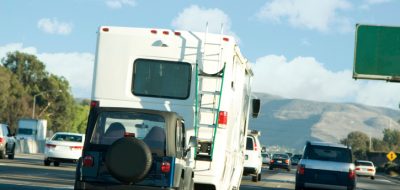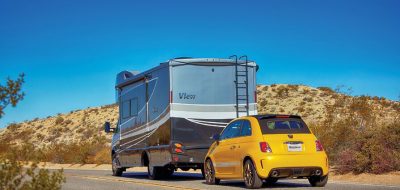Large class C and most class A coaches are challenged when trying to tour cities and local tourist attractions. While the maneuverability is easily managed by a skilled driver, the parking is not. Generally, parking space for these large vehicles is non-existent, leaving your tour confined to what you can see while driving by. A car rental may be the only option. However, there are many campgrounds that may not have the availability of obtaining a rental car. Take my word for it, not even Enterprise will deliver to many locations.
So, what about towing your own car? Towing with your motorhome is an option that you may want to explore. You will always have a car with you and it will save on the rental charges. There are three ways to bring your car with you; full trailer, tow dolly, or flat tow. Let’s look at the advantages and short falls of each.
A full trailer can transport your vehicle with no wear or tear. However this greatly increases your gross combined weight as the trailer itself may well be 2500 lbs. or more. It also requires additional storage both in campgrounds and at home. Disconnecting in emergency circumstances, like the need to turn around on a narrow roadway, can be extremely difficult or not possible. The trailer combination can be backed up if required. Loading and securing takes about 10 minutes or so. Good choice for some applications.
Tow dollies are a popular choice with front wheel drive autos. They carry the front wheels and trail on the rear. Disconnecting on the road, should it be required, is doable. This type of tow can be backed up if needed. Storage, albeit much smaller than the full trailer, is still a requirement. Many times the tongue can be pushed under the motor home in campgrounds. Loading and securing takes about 10 minutes.
The flat tow method is the fastest to hook up and unhook, taking less than 5 minutes. The tow bar can be stored in a locker. However, only certain vehicles can be towed with all wheels down. Confirm your particular vehicle is capable of being towed in this manner first. Additionally, a base plate specific to your car must be installed to provide adaption to the tow bar. This type of towing cannot be backed up, save perhaps a very short distance under some circumstances. After extended accumulated mileage of towing in this manner, the tires of the car may become feathered on the shoulders. This seems to happen more on higher performance rated tires. Never the less, this is probably the preferred towing method used by many motor home owners.
Both the tow dolly and the flat tow require that the rear lights are wired to operate or portable units be employed. Braking systems are also required for all. Simple drop-in brake systems are available for flat tow applications. So, with your dinghy with you, go out and enjoy.





James Okvist
I agree with Frank Hogg. Very limited article. I would like to see a very detailed review of the options. If you feel that you can only put out shorter blogs then break it up into a series. Maybe get different writers that present their preferred option. Last please stop doing ad's for products and parks that pretend to be informational.
James Okvist
I agree with Frank Hogg. Very limited article. I would like to see a very detailed review of the options. If you feel that you can only put out shorter blogs then break it up into a series. Maybe get different writers that present their preferred option. Last please stop doing ad's for products and parks that pretend to be informational.
John Šofranko
And so you wasted even more time to comment.
Bruce Holland
Good article. I certainly prefer flat towing simple to avoid the hassle of trying to park and store a full trailer or dolly. Yeah the fact you can't back up is a hassle, but the disconnect is so fast it is really not a big deal.